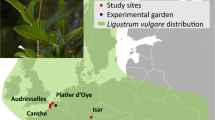Summary
Seed set after self-pollination confirmed that 19 lines of Brassica napus were self-incompatible. Eight lines, H, J, Q, W, X, K, P and Z, were fully cross-compatible. Line R was cross-compatible with these lines but often had a low seed set as female parent. These results are consistent with the activity of nine distinct S-alleles. Line S was cross-incompatible with K, as was V with P, and F with Z. With each of the lines A, E, B, O, G, L and M at least one reciprocal difference was found so that the number of additional distinct S-alleles could not be inferred, but there must be a minimum of seven.
Pollen tube counts of intra- and inter-line pollinations using M, B and X confirmed the homozygosity of these lines with respect to self-incompatibility status and the presence of non-reciprocal compatibility between M and B.
The results are interpreted in terms of the activity of both B. oleracea and B. campestris S-loci and the implications for hybrid breeding are discussed.
Similar content being viewed by others
References
Bateman A.J., 1955. Self-incompatibility systems in Angiosperms. III. Cruciferae. Heredity Lond 9: 53–68.
Davey, V.McM., 1938. Root Crops. In: Report of the Scottish Society for Research in Plant Breeding for 1938, pp 28–31.
Davey, V.McM., 1958. Root Crops. In: Scottish Plant Breeding Station Report 1958, pp 17–18.
Gowers, S., 1973. Hybrid swedes. In: Scottish Plant Breeding Station Annual Report 1972–73, pp 12–13.
Gowers S., 1974a. The production of F1 hybrid swedes (Brassica napus ssp. rapifera) by the utilisation of self-incompatibility. Euphytica 23: 205–208.
Gowers, S., 1974b. Hybrid swedes. In: Scottish Plant Breeding Station Annual Report 1973–74, pp 12–13.
Gowers S., 1975. Methods of producing F1 hybrid swedes (Brassica napus ssp. rapifera). Euphytica 24: 537–541.
Gowers S., 1980. The production of hybrid oil-seed rape using self-incompatibility. Eucarpia Cruciferae Newsletter 5: 15–16.
Gowers S., 1981. Self-pollination in swedes (Brassica napus ssp. rapifera) and its implications for cultivar production. Euphytica 30: 813–817.
Gowers S., 1982. The transfer of characters from Brassica campestris L. to Brassica napus L.: production of clubroot-resistant oil-seed rape (B. napus ssp. oleifera). Euphytica 31: 971–976.
Gowers, S., 1986. Possible applications of self-incompatibility in the production of Brassica napus cultivars. DSIR Plant Breeding Symposium 1986, N.Z. Agronomy Society Special Publication No. 5: 63–66.
Heslop-Harrison J. & Y. Heslop-Harrison, 1970. Evaluation of pollen viability by enzymatically induced fluorescence: intercellular hydrolysis of fluorescein diacetate. Stain Technol. 45: 115–120.
Hinata K. & K. Okazaki, 1986. Role of stigma in the expression of self-incompatibility in crucifers in view of genetic analysis. In: D.L. Mulcahy, G.B. Mulcahy & E. Ottaviano (Eds.), Biotechnology and Ecology of Pollen. Springer-Verlag, New York, pp 185–190.
Hodgkin T., 1986. Self-incompatibility reactions in a synthetic Brassica napus line. Eucarpia Cruciferae Newsletter 11: 77–78.
Kho Y.O. & J. Baer, 1968. Observing pollen tubes by means of flurorescence. Euphytica 17: 298–302.
MacKay G.R., 1976. Self-incompatibility in forage rape, Brassica napus L. var. biennis. Incompatibility Newsletter 7: 4–8.
MacKay G.R., 1977a. A diallel cross method for the recognition of S-allele homozygotes in turnip, Brassica campestris L. ssp. rapifera. Heredity 38: 201–208.
MacKay G.R., 1977b. The introgression of S-alleles into forage rape, Brassica napus L. from turnip, Brassica campestris L. ssp. rapifera. Euphytica 26: 511–519.
MacKay, G.R., 1977c. Turnip (B. campestris) × rape (B. napus) hybrids. In: Scottish Plant Breeding Station Annual Report 1976–77, pp 32–33.
Olsson G., 1960a. Self-incompatibility and outcrossing in rape and white mustard. Hereditas 46: 241–252.
Olsson G., 1960b. Species crosses within the genus Brassica. II. Artificial Brassica napus L. Hereditas 46: 351–386.
Olsson G. & S. Ellerstrom, 1980. Polyploidy breeding in Europe. In: S. Tsunoda, K. Hinata & C. Gomez-Campo (Eds.), Brassica crops and wild allies. Biology and Breeding. Japan Scientific Societies Press, Tokyo, pp 167–190.
Richards R.A., & N. Thurling, 1973. The genetics of self-incompatibility in Brassica campestris L. ssp. oleifera Metzg. I. Characteristics of S-locus. Control of self-incompatibility. Genetica 44: 428–438.
Thompson K.F., 1957. Self-incompatibility in marrow-stem kale, Brassica oleracea var. acephala. I. Demonstration of a sporophytic system. J Genet 55: 45–60.
Thompson K.F., 1983. Breeding winter oilseed rape, Brassica napus. In: T.G. Coaker (Ed.), Advances in Applied Biology VII. Academic Press, London, pp 1–104.
U., N., 1935. Genome-analysis in Brassica with special reference to the experimental formation of B. napus and peculiar mode of fertilisation. Jap J Bot 7: 389–452.
Author information
Authors and Affiliations
Rights and permissions
About this article
Cite this article
Gemmell, D.J., Bradshaw, J.E., Hodgkin, T. et al. Self-incompatibility in Brassica napus: seed set on crossing 19 self-incompatible lines. Euphytica 42, 71–77 (1989). https://doi.org/10.1007/BF00042617
Received:
Accepted:
Issue Date:
DOI: https://doi.org/10.1007/BF00042617




